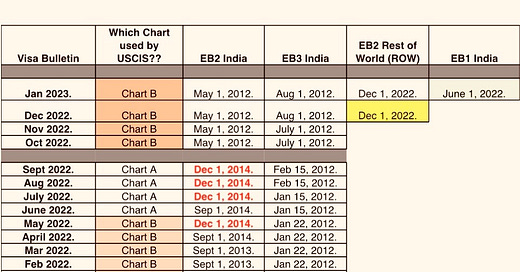Jan 2023 Visa Bulletin Analysis: Cut-Off Dates come to EB1 India/China and continue for EB2 ROW (Rest of World)
This post analyzes the continuing challenges of Employment-Based (EB) immigrants as a result of annual quotas (limits) to EB immigration.
Thank you for reading my newsletter! We are up to over 2,600 subscribers.
###
The January 2023 Visa Bulletin has been issued.
For those not familiar, the Visa Bulletin provides the public with information on who is eligible to process for a green card through various U.S. immigration programs, including Family-Based (FB) and Employment-Based (EB) immigration.
Each month the Visa Bulletin provides two separate charts for FB and two separate charts for EB categories, and then separately and subsequently USCIS - a different agency with its own leadership and priorities - USCIS will issue its own guidance to say which Visa Bulletin chart USCIS will honor for a given month, for purposes of I-485 final stage green card processing.
The graphic above is my creation and shows the cut-off dates over time for key categories, going back to October 2020 - the first month of fiscal year 2021.
Whereas most FB immigrants complete the immigration process through a U.S. consulate, most EB immigrants are already in the United States in another temporary visa status and seek to complete the immigration process through the I-485 adjustment of status application. Thus, understanding ‘which chart’ USCIS will use is particularly important for foreign nationals seeking to file their I-485 applications. The USCIS filing charts can be found here.
For January 2023, USCIS has indicated it will honor “Chart B” which is the more favorable chart for purposes of EB immigration.
The January 2023 Visa Bulletin shows no change versus the December 2022 Visa Bulletin in the cut-off dates for EB-2 India, EB-3 India, or EB-2 Rest of World (ROW).
The January 2023 Visa Bulletin does create a new a cut-off date for EB-1 India/China.
Overall, the January 2023 Visa Bulletin is not good for those trying to immigrate. But ironically, the cut-off dates appear to be the result of USCIS being MORE efficient at processing pending EB I-485 applications.
This post attempts to explain the January 2023 Visa Bulletin and anticipate how dates will move (or not move) in the coming months.
Background on the Visa Bulletin
If you are new to U.S. immigration law, you might consider this overview I have previously written which is a high level summary of U.S. immigration law, in one post. It is obviously not comprehensive but hopefully provides a person new to this world some idea of the issues and concepts involved.
If you are not familiar with the Visa Bulletin, you might consider this primer which covers some background information about the Visa Bulletin in more detail.
Overall, my view is that the most important concept to understand in U.S. immigration law is that there is limited supply (of green cards) and excessive demand (of people seeking green cards). So the whole system is best understood as a system where supply and demand are completely out of sync, and complications emerge as a result of that fundamental fact.
U.S. law limits how many people can immigrate to the United States each fiscal year, based on a relatively convoluted system of categories (also known as “preferences”) along with nationality. So, ‘categories’ and ‘nationality’ are two important variables in determining who gets a green card.
Note also that there is also a fundamental divide on whether you are obtaining your green card based on sponsorship from a family member, or sponsorship through an employer (or self-sponsorship through one of the very limited employment-based categories).
Because there is excess demand, and limited supply, the U.S. Department of State issues a Visa Bulletin each month and uses “cut-off dates” to control the number of green card cases that can be filed and approved.
The goal of the U.S. Department of State each fiscal year is to use up all the available EB immigrant visas, but no more than what is available.
Because it has limited ‘visibility’ on the number of cases ‘out there’ and also limited visibility of how quickly the U.S. Department of State and USCIS approve pending cases, there is a certain disjointed and inefficient movement of the cut-off dates over the course of a fiscal year.
For those familiar with the Federal Reserve and the movement of interest rates by the Federal Reserve, the Visa Bulletin is somewhat akin in the sense that the officials at the U.S. Department of State are like the Federal Reserve Chair - they are ‘data dependent’ and they try to move the cut-off dates like the Fed Chair tries to move interest rates in accordance with data they receive.
The Federal Reserve is supposed to keep inflation and unemployment low.
The U.S. Department of State is supposed to use all the immigrant visa numbers in a given year - but not one more, or one less.
The U.S. government’s fiscal year starts on October 1, so we are currently in Fiscal Year 2023, which will end on September 30, 2023.
January 2023 marks the first month of the second quarter of FY2023. As noted above, this post is about the January 2023 Visa Bulletin - the most recent Visa Bulletin issued as of the time of this writing.
Ongoing Frustration for EB2/EB3 India
If you were born in India, you may already be aware that the EB immigration system is very slow for you. This is because U.S. law has created “per country” limits and those limits greatly impact people born in India.
It is worth noting here that there are two special provisions that are not always understood:
First: Country of birth is what controls the backlogs. So if you were born in UAE but you were a citizen of India at birth, you are permitted to use the country quota of UAE (which is not necessarily backlogged).
Second: If your spouse was born in another country other than India, you are permitted to use your spouse’s country of birth. This is known as “cross-chargeability.”
Two other things to know:
Country of citizenship does not help you so even if you were born in India but became a citizen of Canada, you are subject to the slow India quota system.
Also, cross-chargeability does not apply to children. If your children were born in another country, you cannot use a child’s country of birth - only a spouse’s country of birth is available for cross-chargeability.
The backlogs that have existed for people born in India have existed for many years and they are extremely frustrating. I continue to support and have for 20+ years have supported the end of the per-country quotas. Alas, I am not King and the frustrating country quotas persist, and get worse.
The “per country quotas” keep people born in India from filing final stage I-485 applications although their employers are permitted to file PERM labor certification applications and I-140 immigrant visa petitions at any time.
The country quotas never restrict when an employer can file a PERM application or when an employer can file an I-140 petition.
Further, a self-petition under EB1A or EB2 NIW can be filed at any time.
In October 2020, in the first month of FY2021, there was a dramatic jump forward in the cut-off dates for EB3 India. This led to a huge number of EB I-485 filings by people who had been waiting many years. From October 2020, to September 2022, USCIS tried to approve a record number of EB I-485 applications. In some ways the agency succeeded, in other ways the agency failed. There were a record number of EB green cards available during those two fiscal years as a result of some technical issues in the law tied to the pandemic and the closure of U.S. consulates during the pandemic.
There is no question that a record number of Indians were able to file EB I-485 applications in fall 2020; the main frustration relates to the number of EB I-485 applications approved after the surge in filings.
In October 2022, at the start of FY2023, I had hoped that things would continue to progress for EB2 and EB3 Indians, but unfortunately things have stalled and there has been basically no movement for EB2 and EB3 Indians this fiscal year. And barring a change in the law, it may be difficult to see forward movement in cut-off dates for EB2 or EB3 India any time soon.
EB2 and EB3 Indians with I-485 applications pending will likely have them pending for a long time.
EB2 and EB3 Indians who have not been able to file I-485 applications will not likely be able to file them this fiscal year unless they can somehow upgrade to a category that is current.
There is, without question, huge interest in EB-1 among Indian-born H-1B workers, but the category remains very strict and there is increasing anecdotal evidence that a surge in filings has made adjudicators basically numb.
Month 2 for a Cut-Off Date for EB2 ROW (Rest of World)
In December 2022, and continuing for January 2023, a cut-off date was introduced for EB-2 Rest of World (ROW).
Traditionally for EB immigrants, there are cut-off dates for EB2 and EB3 India and China and occasionally EB3 Philippines (mainly as a result of the very active international nurse programs); but it is NOT common for cut-off dates to exist for other nationalities.
Thus, the emergence of cut-off dates for EB-2 ROW in December 2022 was somewhat of a surprise and I think there are probably many people in the United States and born in countries other than India and China who do not realize these cut-off dates have arrived and what they mean. Indian and Chinese-born immigrants have spent years understanding and incorporating these backlogs into their immigration plans. Immigrants from Europe and Latin America and Canada are only now waking up to what cut-off dates will mean to their immigration plans.
The gif posted above is written in shorthand: “F-1 ROW to GC via EB2 NIW” is essentially an abbreviation for:
“F-1 students from “Rest of World” (not India/China) who are seeking a GC (Green Card) via EB-2 NIW (Employment-Based 2nd Preference National Interest Waiver).”
EB-2 NIW has become, for various reasons, an attractive route for green card processing for F-1 students not born in India or China particularly if they have pursued a STEM-based Master’s degree or Doctorate. And in fact it could be precisely because this immigration route is more well-known and attractive that there is now a backlog in that category.
What this means is that if you are a F-1 student from “Rest of World” - you need to be pro-active and consider moving ahead now, before the backlogs get worse.
The January 2023 Visa Bulletin marks month 2 of the cut-off dates for EB-2 ROW, and my expectation is that the cut-off dates will remain and it is possible that EB-2 ROW will become “unavailable” later this fiscal year due to relatively fast processing by USCIS of EB I-485 applications.
If you are a STEM-based F-1 student not born in India or China, EB-2 NIW may still be a viable route to a green card for you but you will want to plan ahead and potentially act quickly.
Month 1 for a Cut-Off Date for EB1 India/China
It is rare for the EB1 category to be backlogged. This is mainly because it is very hard to qualify for EB1 so the number of people seeking a green card in this category is limited.
But this fiscal year, in only the 4th month of the fiscal year, there is now a cut-off date being introduced for EB1 India and China. The cut-off date is June 1, 2022, which means that in the month of January 2023, only those EB1 immigrants born in India or China who had filed their EB1 I-140 petition before June 1, 2022, are eligible to file their I-485 applications.
It is possible that this EB1 cut-off date will move up during the rest of the fiscal year but it is also possible, like EB2 ROW, that EB1 India and China will become “unavailable” later this fiscal year.
The irony of the situation is that I believe these cut-off dates for EB1 and EB2 ROW are because USCIS is processing EB I-485 applications quickly, and their faster processing means they are using up the annual quota quickly.
Traditionally USCIS has been very slow to process EB I-485 applications and that slow processing meant that the annual quota for EB immigrant visas was generally used up in the last month of the year (September). Traditionally a disproportionate number of EB I-485 applications were approved in summer (4th quarter of the fiscal year). The slow processing of EB I-485 applications allowed for the cut-off dates to stay current for longer.
However, during the last fiscal year (FY2022 that ended September 30, 2022), USCIS revamped its system for processing EB I-485 applications and now uses the National Benefits Center and local field offices. The result of this new approach is that there are many more adjudicators available to review and approve EB I-485 applications, and by processing pending EB I-485 applications much faster, they are using up the annual allotment of green cards much faster, meaning cut-off dates are being introduced sooner in the year and in more categories.
What’s Ahead?
Without a change in the law, I anticipate that the cut-off dates that exist in the January 2023 Visa Bulletin will continue for the rest of the fiscal year, or - as noted above - immigrant visas will become “unavailable” as categories get used up.
I anticipate that EB3 ROW will soon face cut-off dates, particularly as U.S. consulates become more clearly open to processing and issuing EB immigrant visas.
The implications of widespread and worldwide cut-off dates are wide-ranging (and not good). I hope to write about the implications in coming posts. Experienced immigration attorneys and employers who have based strategies and plans on the assumption that certain categories and nationalities will be current need to quickly review and revise plans. That is easier said than done.
I do realize this post has not exactly been good news, but hopefully I have been able to shed some light on the January 2023 Visa Bulletin and the road ahead.
Please feel free to share questions or comments below, and I will do my best to respond.









Thank you so much for your post. It was very helpful. I wanted to clarify something. Based on your explanation, you don't expect the dates for EB2 India to move forward to due the unavailability of visa numbers in the EB2 ROW category. I wanted to ask if you similarly expect ROW EB2 date to remain stuck at the date set in the January 2023 bulletin, at least until the next fiscal year, or do you expect the date for the EB2 ROW to move forward somewhat and then maybe at some point become unavailable when all the visa numbers get used up. Thank you.
Thank you for the post. Why do you think EB2 dates will not move further during 2023? Reason was not clear to me.